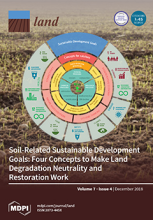Land Library
Welcome to the Land Portal Library. Explore our vast collection of open-access resources (over 74,000) including reports, journal articles, research papers, peer-reviewed publications, legal documents, videos and much more.
/ library resources
Showing items 10 through 18 of 124.Centuries of colonization of the Atlantic Forest biome in Brazil have led its native vegetation cover to be reduced to only 11.7%. On the other hand, regional land changes have fostered natural forest regeneration, since the 1960s, in the region of Paraíba Valley.
West African savannas are experiencing rapid land cover change that threatens biodiversity and affects ecosystem productivity through the loss of habitat and biomass, and carbon emissions into the atmosphere exacerbating climate change effects.
New approaches to collect in-situ data are needed to complement the high spatial (10 m) and temporal (5 d) resolution of Copernicus Sentinel satellite observations. Making sense of Sentinel observations requires high quality and timely in-situ data for training and validation.
When applying traditional criteria of Roman urbanism, several settlements in the province of Moesia are not recognised as parts of the urban network. To avoid this, previous criteria of urbanism should be revised.
In recent years, the scientific interest for the economic and landscape impact of wind farms has increased.
Small protected areas dominate some databases and are common features of landscapes, yet their accumulated contributions to biodiversity conservation are not well known.
Cambodia has become a principal target of transnational (and domestic) land grabs over the past decade, mostly in the form of economic land concessions (ELCs). The northeastern part of the country—where the majority of Cambodia’s indigenous people reside—is a particular hotspot.
Scholars and practitioners have great interest in topics related to spatial patterns and the organization and properties of space. Landscape urbanism is one of these topics of interest.
Urban agriculture is said to be increasing with global urbanization. However, there is little examination of the temporal or spatial dynamics of urban agriculture.

